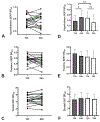The response to prolonged fasting in hypothalamic serotonin transporter availability is blunted in obesity
- PMID: 34331964
- PMCID: PMC8994212
- DOI: 10.1016/j.metabol.2021.154839
The response to prolonged fasting in hypothalamic serotonin transporter availability is blunted in obesity
Abstract
Background and aims: Serotonergic and dopaminergic systems in the brain are essential for homeostatic and reward-associated regulation of food intake and systemic energy metabolism. It is largely unknown how fasting influences these systems or if such effects are altered in humans with obesity. We therefore aimed to evaluate the effects of fasting on hypothalamic/thalamic serotonin transporter (SERT) and striatal dopamine transporter (DAT) availability in lean subjects and subjects with obesity.
Methods: In this randomized controlled cross-over trial, we assessed the effects of 12 vs 24 h of fasting on SERT and DAT availability in the hypothalamus/thalamus and striatum, respectively, using SPECT imaging in 10 lean men and 10 men with obesity.
Results: As compared with the 12-h fast, a 24-h fast increased hypothalamic SERT availability in lean men, but not in men with obesity. We observed high inter-individual variation in the effects of fasting on thalamic SERT and striatal DAT, with no differences between lean men and those with obesity. In all subjects, fasting-induced increases in circulating free fatty acid (FFA) concentrations were associated with an increase in hypothalamic SERT availability and a decrease in striatal DAT availability. Multiple regression analysis showed that changes in plasma insulin and FFAs together accounted for 44% of the observed variation in striatal DAT availability.
Conclusion: Lean men respond to prolonged fasting by increasing hypothalamic SERT availability, whereas this response is absent in men with obesity. Inter-individual differences in the adaptations of the cerebral serotonergic and dopaminergic systems to fasting may, in part, be explained by changes in peripheral metabolic signals of fasting, including FFAs and insulin.
Keywords: Dopamine; Fasting; Food intake; Obesity; SPECT; Serotonin.
Copyright © 2021 The Authors. Published by Elsevier Inc. All rights reserved.
Conflict of interest statement
Declaration of competing interest The authors declare that there is no conflict of interest associated with the manuscript.
Figures





References
-
- Organization, W.H. Factsheet: obesity and overweight; March 03, 2020.
-
- Swinburn BA, et al. The global obesity pandemic: shaped by global drivers and local environments. Lancet. 2011;378(9793):804–14. - PubMed
-
- Bluher M Obesity: global epidemiology and pathogenesis. Nat Rev Endocrinol. 2019;15(5):288–98. - PubMed
-
- Schwartz MW, et al. Central nervous system control of food intake. Nature. 2000;404 (6778):661–71. - PubMed
Publication types
MeSH terms
Substances
Grants and funding
LinkOut - more resources
Full Text Sources
Other Literature Sources
Medical
Research Materials

